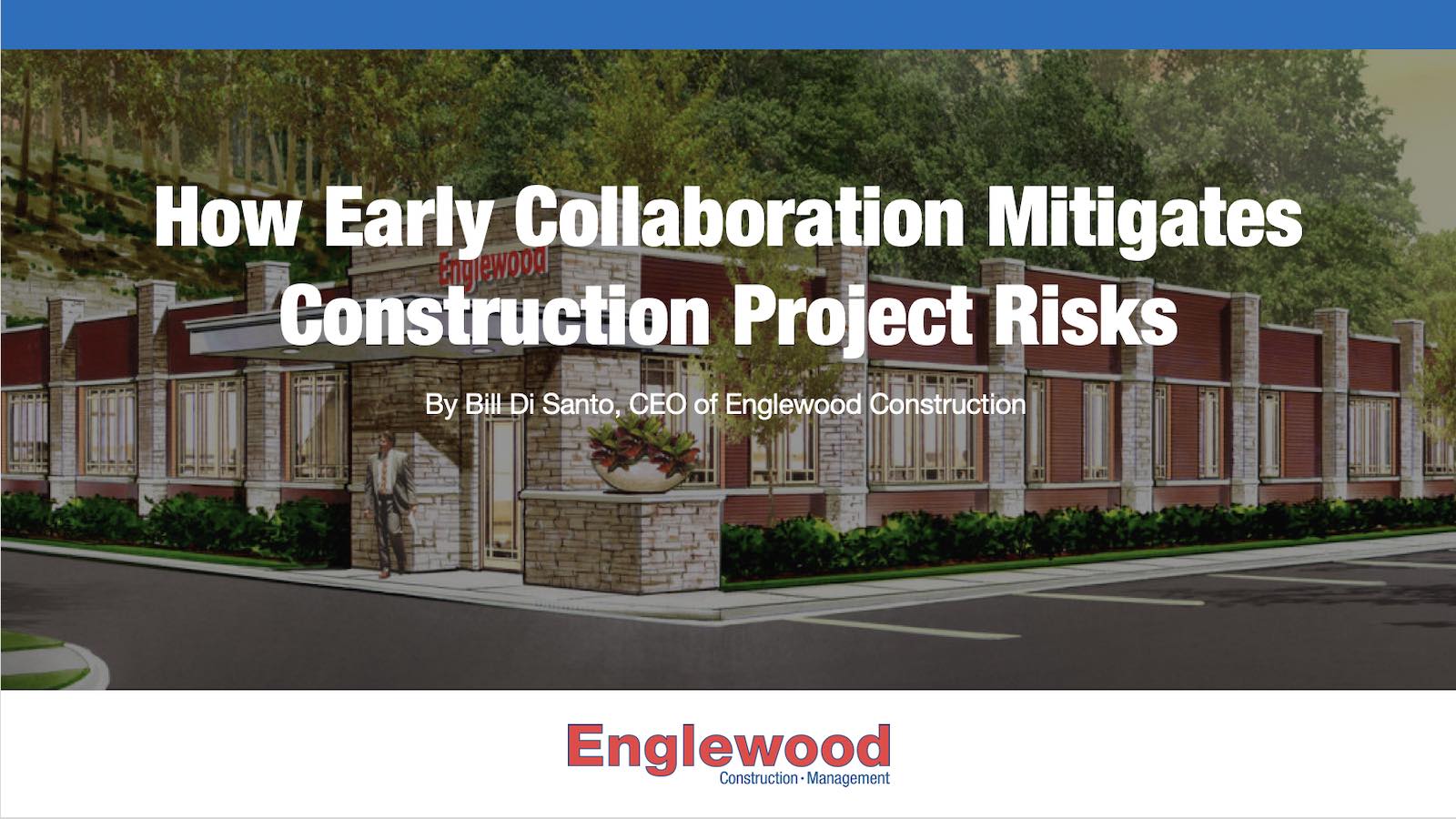Early Collaboration: The Key to Commercial Construction Risk Mitigation
Over the past 20+ years, Englewood has completed over 2500 commercial construction projects in the retail, restaurant, hospitality, senior living, industrial, cannabis, and automotive sectors. Working with some of the best Directors of Construction, architects, and project managers in the business, we understand that risk management is a core concern for our clients. From financial overruns to project delays, unexpected risks can impact budgets, timelines, and overall project success. Yet, with strategic planning, collaboration, and communication, we have learned how to collaborate to proactively manage these risks, ensuring smoother project delivery and protecting investments.
Early Collaboration with the entire team, including your national contractor, is the key to mitigating risks and achieving better results
In commercial construction, early collaboration between Directors of Construction and General Contractors (GCs) can be the difference between a successful project and costly delays or budget overruns. Traditionally, GCs are brought into projects after the design is completed, but involving them earlier offers significant advantages that reduce risks and increase efficiency. By working with GCs at the start of a project, the client’s full construction team can better anticipate challenges, establish clear communication, and ensure the project is set up for success.
Here are several strategies for achieving better project outcomes through early collaboration:
1. Early Engagement for Improved Decision-Making
Engaging GCs early provides Directors with critical insights that enhance the project’s overall design and feasibility. When GCs participate in the planning and design phases, they can identify constructability issues, optimize designs, and establish realistic budgets and timelines. This proactive approach reduces costly revisions and unexpected scope changes, helping to keep the project on track.
For example, at Englewood Commercial Construction, early collaboration is a core part of our process. By involving all stakeholders from the beginning, Englewood can identify potential challenges and work with architects, engineers, and clients to make adjustments before construction begins. This early planning minimizes the risk of disruptions and keeps the project aligned with its budget and schedule.
2. Aligning Goals and Establishing Communication Protocols
Clear communication is essential for a successful project, and early collaboration ensures that the client and GC is aligned on project goals from the outset. A structured communication framework—such as regular meetings, real-time updates, and a shared project management platform—keeps all stakeholders informed and allows quick responses to emerging issues.
In a mixed-use development project, Englewood’s consistent communication with the Director of Construction helped keep the project aligned with objectives and enabled efficient problem-solving as issues arose. This proactive approach prevented misunderstandings, minimized delays, and reduced costs by ensuring that everyone stayed on the same page throughout the project.
3. Comprehensive Preconstruction Planning
The preconstruction phase is crucial for setting a strong foundation. During this stage, the client/GC team collaboratively address site assessments, permit requirements, and scheduling, leveraging the GC’s practical experience in the field. GCs provide insights that help ensure regulatory compliance, address logistical issues, and anticipate supply chain needs.
For instance, in a restaurant construction project, Englewood’s early involvement allowed us to resolve foundational requirements and permitting challenges, which could have otherwise delayed the project. By working together during preconstruction, our team was able to develop a roadmap that prepared the project for potential challenges, ensuring a smoother process and better budget control.
4. Accurate Budgeting and Scheduling
Budget overruns and schedule delays are common risks in construction, but they can be better managed when GCs are involved early in budgeting and scheduling. GCs can provide accurate estimates for labor costs, materials, and realistic timelines, allowing Directors to establish a reliable budget with contingencies for unforeseen circumstances.
Englewood’s approach in multi-location projects involves working closely with the client to create a phased schedule and budget that accounts for seasonal material availability and local permitting timelines. This collaborative budgeting and scheduling process helps minimize unexpected expenses and ensure the project progresses according to plan.
5. Proactive Management of Change Orders
Change orders are often unavoidable in construction, but they can introduce risks if not managed effectively. By establishing a process for handling change orders collaboratively, Directors and the GC can control the impact of changes on the project’s timeline, budget, and quality. This approach ensures that changes are essential, justified, and financially accounted for.
For example, in a senior living facility project, Englewood worked with the Director of Construction to implement a clear change order process, allowing both parties to evaluate and approve modifications before they were implemented. This process kept the project aligned with its budget and timeline, reducing scope creep and enabling a more streamlined workflow.
6. Collaborative Safety Planning and Compliance
Safety and regulatory compliance are critical elements of risk mitigation in construction. By collaborating on safety protocols and compliance monitoring from the start, the client and GC can create a unified approach to safety that minimizes on-site accidents and ensures adherence to industry standards.
In a large retail development project, for example, Englewood collaborated with our client to conduct weekly safety drills and implement regular compliance checks. These proactive safety measures reduced the risk of on-site incidents, minimized legal risks, and kept the project in line with OSHA requirements. Joint safety planning reinforces a safe work environment, protects project timelines, and safeguards against costly delays.
7. Leveraging Technology for Real-Time Tracking and Communication
Modern construction technology provides powerful tools for real-time project tracking and data sharing. By deciding early on which digital tools to use, we can ensure everyone has access to accurate, up-to-date project information. Platforms for project management, scheduling, and reporting improve transparency and allow quick adjustments as conditions change.
Englewood’s use of centralized project management tools like PROCORE, facilitates coordination between off-site managers and on-site teams, enabling faster decision-making and reducing the risk of delays. With shared access to project data, we can respond effectively to any changes, enhancing overall project efficiency and communication.
8. Maintaining High Standards through Quality Control
Quality control is essential for a successful project, and early collaboration enables us to set shared quality standards from the outset. Establishing benchmarks, routine inspections, and performance testing throughout the project helps ensure that construction meets design specifications and regulatory standards.
For instance, on a recent automotive retail build-out, Englewood and the client implemented a system of quality inspections at key milestones, keeping the project on schedule and reducing rework. This commitment to quality control boosts project value, ensures compliance, and builds trust between the client and the contractor.
The Value of Early Collaboration in Construction
For Directors of Construction, engaging your GC early is a strategic move that improves risk management, enhances project efficiency, and promotes a smoother construction process. By establishing aligned goals, proactive communication, robust safety protocols, and quality standards, Directors and the GC create a seamless, predictable experience from start to finish. Englewood’s early involvement, client-centered approach, and extensive expertise make us an ideal partner for delivering successful construction projects.
Why Englewood
Englewood Commercial Construction combines a national footprint with a personalized, hands-on approach, making us an ideal partner for Directors of Construction. With a network of over 20,000 vetted subcontractors across 45 states, Englewood provides both reliability and regional expertise. Our commitment to collaboration, transparency, and efficiency at every stage of a project ensures that Directors can achieve high-quality results across a diverse range of projects




